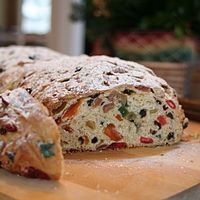Type Fruit cake | Region or state Saxony | |
 | ||
Main ingredients candied fruit or dried fruit, nuts, spices (cardamom and cinnamon); sugar, powdered sugar or icing sugar Similar Panettone, Marzipan, Lebkuchen, Gugelhupf, Yule log | ||
Christmas stollen recipe in the bread kitchen
Stollen ( [ˈʃtɔlən̩]) ( listen )( [ˈʃtɔln̩]) ( listen ) is a fruit bread containing dried fruit and often covered with powdered sugar or icing sugar. The bread is usually made with chopped candied fruit and/or dried fruit, nuts and spices. Stollen is a traditional German bread usually eaten during the Christmas season, when it is called Weihnachtsstollen (after "Weihnachten", the German word for Christmas) or Christstollen (after Christ).
Contents
- Christmas stollen recipe in the bread kitchen
- Christmas stollen recipe
- History
- Dresden Stollen festival
- References
Stollen is a cake like fruit bread made with yeast, water and flour, and usually with zest added to the dough. Candied orange peel (Orangeat) and candied citrus peel (Zitronat), raisins and almonds, and different spices such as cardamom and cinnamon are added. Other ingredients, such as milk, sugar, butter, salt, rum, eggs, vanilla, other dried fruits and nuts and marzipan may also be added to the dough. Except for the fruit added, the dough is quite low in sugar. The finished bread is sprinkled with icing sugar. The traditional weight of Stollen is around 2.0 kg (4.4 lb), but smaller sizes are now available. However, because it is slathered with melted unsalted butter and rolled in sugar as soon as it comes out of the oven, it results in a much better-keeping and moister product. The marzipan rope in the middle is optional. The dried fruits are macerated in rum or brandy for a superior tasting bread.
Dresden Stollen (originally Striezel), a moist, heavy bread filled with fruit, was first mentioned in an official document in 1474, and Dresdner Stollen remains notable and available - amongst other places - at the Dresden Christmas market, the Striezelmarkt. Dresden Stollen is produced in the city of Dresden and distinguished by a special seal depicting King Augustus II the Strong. This "official" Stollen is produced by only 150 Dresden bakers.
Christmas stollen recipe
History
Early Stollen was different, with the ingredients being flour, oats and water. As a Christmas bread stollen was baked for the first time at the Council of Trent in 1545, and was made with flour, yeast, oil and water.
The Advent season was a time of fasting, and bakers were not allowed to use butter, only oil, and the cake was tasteless and hard. In the 15th century, in medieval Saxony (in central Germany, north of Bavaria and south of Brandenburg), the Prince Elector Ernst (1441–1486) and his brother Duke Albrecht (1443–1500) decided to remedy this by writing to the Pope in Rome. The Saxon bakers needed to use butter, as oil in Saxony was expensive, hard to come by, and had to be made from turnips.
Pope Nicholas V (1397–1455), in 1450denied the first appeal. Five popes died before finally, Pope Innocent VIII, (1432–1492) in 1490 sent a letter to the Prince, known as the "Butter-Letter" which granted the use of butter (without having to pay a fine), but only for the Prince-Elector and his family and household.
Others were also permitted to use butter, but on the condition of having to pay annually 1/20th of a gold Gulden to support the building of the Freiberg Minster. The ban on butter was removed when Saxony became Protestant.
Over the centuries, the bread changed from being a simple, fairly tasteless "bread" to a sweeter bread with richer ingredients, such as marzipan, although traditional Stollen is not as sweet, light and airy as the copies made around the world.
Dresden Stollen festival
Every year Stollenfest takes place in Dresden. This historical tradition ended only in 1918 with the fall of the monarchy, and started again in 1994, but the idea comes from Dresden’s history.
Dresden’s Christmas market, the Striezelmarkt, was mentioned in the chronicles for the first time in 1474.
The tradition of baking Christmas Stollen in Dresden is very old. Christmas Stollen in Dresden was already baked in the 15th century.
In 1560, the bakers of Dresden offered the rulers of Saxony Christmas Stollen weighing 36 pounds each as gift, and the custom continued.
Augustus II the Strong (1670–1733) was the Elector of Saxony, King of Poland and the Grand Duke of Lithuania. The King loved pomp, luxury, splendour and feasts. In 1730, he impressed his subjects, ordering the Bakers’ Guild of Dresden to make a giant 1.7-tonne Stollen, big enough for everyone to have a portion to eat. There were around 24,000 guests who were taking part in the festivities on the occasion of the legendary amusement festivity known as Zeithainer Lustlager. For this special occasion, the court architect Matthäus Daniel Pöppelmann (1662–1737), built a particularly oversized Stollen oven. An oversized Stollen knife also had been designed solely for this occasion.
Today, the festival takes place on the Saturday before the second Sunday in Advent, and the cake weighs between three and four tonnes. A carriage takes the cake in a parade through the streets of Dresden to the Christmas market, where it is ceremoniously cut into pieces and distributed among the crowd, for a small sum which goes to charity. A special knife, the Grand Dresden Stollen Knife, a silver-plated knife, 1.60 meters long weighing 12 kg, which is a copy of the lost baroque original knife from 1730, is used to festively cut the oversize Stollen at the Dresden Christmas fair.
The largest Stollen was baked in 2010 by Lidl; it was 72.1 meters long and was certified by the Guinness Book of World Records, at the train station of Haarlem.
